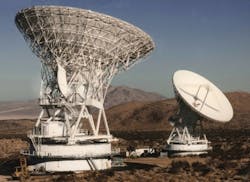Two 112-foot dish antennas for deep space exploration missions to be provided to NASA by GD SATCOM
NEWTON, N.C., 20 Jan. 2011.Deep-space exploration experts at the NASA Jet Propulsion Laboratory in Pasadena, Calif., needed two 112-foot beam waveguide antennas at the Deep Space Network (DSN) facility in Canberra, Australia, to help study Earth as well as explore distant bodies in the solar system. They found their solution from General Dynamics SATCOM Technologies in Newton, N.C.
GD SATCOM won a $40.7 million NASA JPL contract for the two 34-meter dish antennas as part of NASA's modernization and transformation plan for Earth and space exploration. Construction, integration and testing for the two new antennas, designated Deep Space Stations 35 and 36, are scheduled for completion by 2014 and 2016.
Originally designed by JPL and built by General Dynamics, the antennas enable the Deep Space Network to communicate with existing flight missions such as the Mars Exploration Rovers, Spitzer Space telescope, Saturn explorer Cassini, as well as support future NASA space missions.
Beam waveguide-style antennas house sensitive electronics and systems in a room inside the antenna's ground-based pedestal, rather than in the center of the dish or reflector. This design makes it easier for technicians to maintain and upgrade the equipment.
GD SATCOM has built nine 34-meter antennas for NASA's Deep Space Network. The Jet Propulsion Laboratory, a division of the California Institute of Technology, manages the Deep Space Network for NASA. NASA's Deep Space Network is an international collection of antennas that support NASA's spacecraft missions as well as radar and radio observatories that explore the solar system and universe.
There are three Deep Space Network facilities, located 120 degrees apart, in California, Spain, and Australia. This strategic placement enables constant observation and communication as the Earth rotates, making the Deep Space Network one of the largest and most sensitive scientific telecommunications systems in the world, say officials of GD SATCOM, which is part of General Dynamics C4 Systems in Scottsdale, Ariz.
For more information contact GD SATCOM online at www.gdsatcom.com, or the Jet Propulsion Laboratory at www.jpl.nasa.gov.

